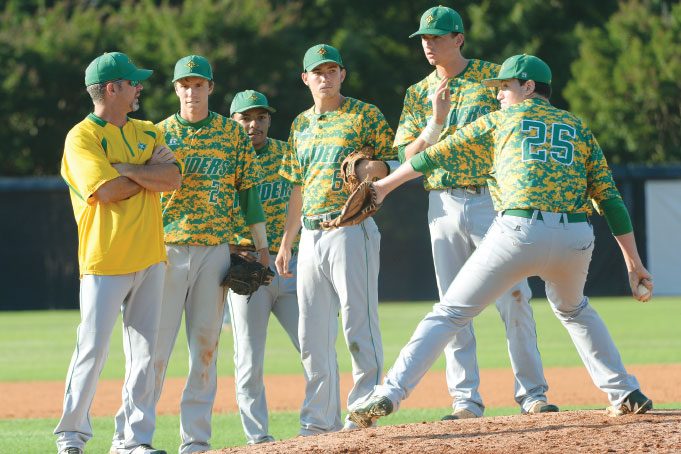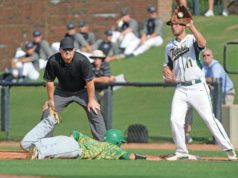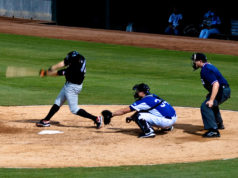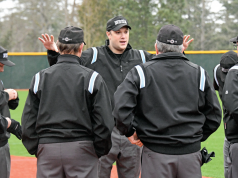During the 2017 MLB season, 61 percent of the innings were pitched by the starting pitchers. That left over one-third of the innings for relief pitchers.
Umpires must understand when relief pitchers can enter the game and what they must do before they can be replaced. Except where noted, the material applies equally to NFHS, NCAA and pro rules.
Replacing the starter. The player named on the starting lineup as the pitcher must remain in the game until the first batter completes his “at bat” (reaches first base or is put out) (NFHS 3-1-1; NCAA 5-5b; pro 5.10f). The only exceptions are if the pitcher is injured, becomes ill or is ejected. Under NFHS rules, the starting pitcher can be pinch hit for in the top of the first, because each starter may withdraw and re-enter once, including the pitcher. The re-entered starter would then face the first batter in the bottom of the first. Under NCAA and pro rules, once a player is removed from the game, he cannot re-enter (NCAA 5-5j; pro 5.10d). Legal substitutions may be made at any time the ball is dead. The umpire-in-chief must be immediately notified and “time” must be requested to make a substitution.
Replacing the reliever. Any substitute pitcher must pitch to the batter then at bat or any substitute until that batter completes his at-bat or the third out is made (NFHS 3-1-2; NCAA 5-5b; pro 5.10g).
Play 1: Don relieves John with no one out and the bases loaded in the top of the seventh inning. The offensive coach substitutes a right-handed batter to face the left-handed reliever. The defensive coach comes out to bring in a new left-hander to face the pinch hitter. Ruling 1: Not allowed.
Play 2: Joe relieves Jim with two outs and Harry on first base in the top of the sixth inning. Harry is picked off by Joe before a pitch is thrown to the batter. Ruling 2: Joe has fulfilled his obligation by retiring the side. Another pitcher may begin the top of the seventh.
Returning pitcher. In an April 30, 2017, game, the Orioles and Yankees were tied, 4-4, in the top of the 10th inning. Aroldis Chapman, the Yankees’ sixth pitcher, relieved Bryan Mitchell after Mitchell tossed a scoreless ninth. The Yankees were out of fresh relievers, so Yankee manager Joe Girardi moved Mitchell to first base so he could pitch the 11th inning if necessary.
While that was an unusual move for MLB, a pitcher playing another defensive position happens more frequently in amateur baseball. When that takes place, the pitcher can return to the mound once per inning in NFHS and pro, but only once per game in NCAA (NFHS 3-1-2; NCAA 5-5b AR 1, 7-2d2c, 9-4e; pro 5.10d Cmt). When a replaced pitcher remains in the game, the DH is lost in NCAA and pro.
Play 3: In the third inning, the coach goes to the mound and brings in Jones, the first baseman, to pitch. The original pitcher leaves the game and a new first baseman, Green, comes into the game. After one batter, the coach swaps F3 (Green) with F1 (Jones). The new pitcher, Green (old F3), retires two batters. The coach then returns the two players to their original positions. Jones walks the next batter. The coach repeats the switch so that Jones is at first again and Green pitching. Ruling 3: Legal. Both Jones and Green left the mound once and returned one time. Green may continue to pitch, but in NCAA, Jones cannot return to the mound for the remainder of the game.
Removal mandated. Coaches are allowed to visit pitchers on a limited basis, but sometimes the trip to the mound must result in a relief pitcher. Under NFHS rules, each team is allowed three charged defensive conferences for a regulation game. A mound visit that results in a pitching change is not a charged conference. Once the allowed conferences are used, the pitcher must be removed on any subsequent visits to the mound and cannot return as the pitcher in that game (NFHS 3-4-1).
In NCAA play, the rule is the same as NFHS except the pitcher must be removed for the duration of the game on the second visit in the same inning regardless of the total number of visits (NCAA 9-4a, 9-4b). In a game played under pro rules, a manager or coach may make a trip to the mound for any one pitcher once per inning. A second trip to the same pitcher in the same inning requires the pitcher be removed from the game (5.10L2).
Additionally, in NCAA and pro, a second trip cannot be made while the same batter is at bat, although if there is a pinch hitter, the second trip is legal, but the pitcher must be removed. For purposes of this rule, the next batter is the batter as soon as the previous batter finishes his at-bat (NCAA 9-4b, 9-4c; pro 5.10l3, 4). The coach need not wait for the new batter to step into the box before coming out. In high school play, all three conferences can be held in the same inning with the same pitcher and the same batter.
Play 4: B5 draws a walk to load the bases. As B6 steps to the plate, the coach comes out to visit F1. F1’s next two pitches to B6 are in the dirt; the coach returns. Ruling 4: Legal in NFHS, but not in NCAA or pro.
It should also be noted that in 2018, in the interest of speeding up the game, pro baseball added a six-visit maximum for mound visits per game.
What's Your Call? Leave a Comment:
Note: This article is archival in nature. Rules, interpretations, mechanics, philosophies and other information may or may not be correct for the current year.
This article is the copyright of ©Referee Enterprises, Inc., and may not be republished in whole or in part online, in print or in any capacity without expressed written permission from Referee. The article is made available for educational use by individuals.


















